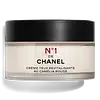What's inside
What's inside
 Key Ingredients
Key Ingredients

 Benefits
Benefits

 Concerns
Concerns

No concerns
 Ingredients Side-by-side
Ingredients Side-by-side

Camellia Japonica Flower Water
Skin ConditioningWater
Skin ConditioningGlycerin
HumectantButylene Glycol
HumectantSqualane
EmollientSodium Acrylates Copolymer
Propanediol
SolventAlbizia Julibrissin Bark Extract
MaskingCamellia Japonica Seed Oil
EmollientSaccharomyces Cerevisiae Extract
Skin ConditioningFaex
Skin ConditioningCamellia Japonica Flower Extract
EmollientSigesbeckia Orientalis Extract
Skin ConditioningPentylene Glycol
Skin ConditioningEthylhexylglycerin
Skin ConditioningCellulose
AbsorbentLecithin
EmollientPhospholipids
Skin ConditioningSclerotium Gum
Emulsion StabilisingChlorphenesin
AntimicrobialEscin
TonicCaprylyl Glycol
EmollientCyamopsis Tetragonoloba Gum
Emulsion StabilisingMaltodextrin
AbsorbentBeta-Sitosterol
Emulsion StabilisingArginine
MaskingTocopherol
AntioxidantAdenosine
Skin ConditioningSodium Hyaluronate
HumectantLactic Acid
Buffering1,2-Hexanediol
Skin ConditioningTin Oxide
AbrasiveSodium Benzoate
MaskingPalmitoyl Tetrapeptide-7
Skin ConditioningCI 77891
Cosmetic ColorantMica
Cosmetic ColorantCamellia Japonica Flower Water, Water, Glycerin, Butylene Glycol, Squalane, Sodium Acrylates Copolymer, Propanediol, Albizia Julibrissin Bark Extract, Camellia Japonica Seed Oil, Saccharomyces Cerevisiae Extract, Faex, Camellia Japonica Flower Extract, Sigesbeckia Orientalis Extract, Pentylene Glycol, Ethylhexylglycerin, Cellulose, Lecithin, Phospholipids, Sclerotium Gum, Chlorphenesin, Escin, Caprylyl Glycol, Cyamopsis Tetragonoloba Gum, Maltodextrin, Beta-Sitosterol, Arginine, Tocopherol, Adenosine, Sodium Hyaluronate, Lactic Acid, 1,2-Hexanediol, Tin Oxide, Sodium Benzoate, Palmitoyl Tetrapeptide-7, CI 77891, Mica
 Reviews
Reviews

Ingredients Explained
These ingredients are found in both products.
Ingredients higher up in an ingredient list are typically present in a larger amount.
Caprylyl Glycol is a humectant and emollient, meaning it attracts and preserves moisture.
It is a common ingredient in many products, especially those designed to hydrate skin. The primary benefits are retaining moisture, skin softening, and promoting a healthy skin barrier.
Though Caprylyl Glycol is an alcohol derived from fatty acids, it is not the kind that can dry out skin.
This ingredient is also used as a preservative to extend the life of products. It has slight antimicrobial properties.
Learn more about Caprylyl GlycolGlycerin is already naturally found in your skin. It helps moisturize and protect your skin.
A study from 2016 found glycerin to be more effective as a humectant than AHAs and hyaluronic acid.
As a humectant, it helps the skin stay hydrated by pulling moisture to your skin. The low molecular weight of glycerin allows it to pull moisture into the deeper layers of your skin.
Hydrated skin improves your skin barrier; Your skin barrier helps protect against irritants and bacteria.
Glycerin has also been found to have antimicrobial and antiviral properties. Due to these properties, glycerin is often used in wound and burn treatments.
In cosmetics, glycerin is usually derived from plants such as soybean or palm. However, it can also be sourced from animals, such as tallow or animal fat.
This ingredient is organic, colorless, odorless, and non-toxic.
Glycerin is the name for this ingredient in American English. British English uses Glycerol/Glycerine.
Learn more about GlycerinPentylene glycol is typically used within a product to thicken it. It also adds a smooth, soft, and moisturizing feel to the product. It is naturally found in plants such as sugar beets.
The hydrophilic trait of Pentylene Glycol makes it a humectant. As a humectant, Pentylene Glycol helps draw moisture from the air to your skin. This can help keep your skin hydrated.
This property also makes Pentylene Glycol a great texture enhancer. It can also help thicken or stabilize a product.
Pentylene Glycol also acts as a mild preservative and helps to keep a product microbe-free.
Some people may experience mild eye and skin irritation from Pentylene Glycol. We always recommend speaking with a professional about using this ingredient in your routine.
Pentylene Glycol has a low molecular weight and is part of the 1,2-glycol family.
Learn more about Pentylene GlycolSodium Hyaluronate is hyaluronic acid's salt form. It is commonly derived from the sodium salt of hyaluronic acid.
Like hyaluronic acid, it is great at holding water and acts as a humectant. This makes it a great skin hydrating ingredient.
Sodium Hyaluronate is naturally occurring in our bodies and is mostly found in eye fluid and joints.
These are some other common types of Hyaluronic Acid:
Learn more about Sodium HyaluronateWater. It's the most common cosmetic ingredient of all. You'll usually see it at the top of ingredient lists, meaning that it makes up the largest part of the product.
So why is it so popular? Water most often acts as a solvent - this means that it helps dissolve other ingredients into the formulation.
You'll also recognize water as that liquid we all need to stay alive. If you see this, drink a glass of water. Stay hydrated!
Learn more about Water